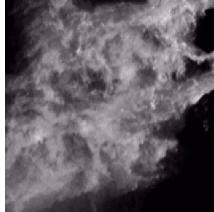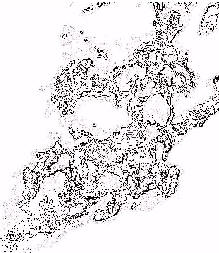Multifractal, energy cascades, self-similarity and self regularized inflow and outflow
...The most characteristic feature of turbulence is its multifractal nature. A fractal is a geometric object, in which self-similar geometric patterns are embedded in smaller and smaller scales. Fractals are simpler objects than the multifractals. In a fractal network of void and matter, if one scoops up an area of certain dimension, from anywhere from the network, one will ind similar amount of matter and void in every samples, which defines the measures of the fractal. However, in a multifractal it will be different. Instead of the whole fractal showing the same measure everywhere, the areas of similar measures will form different fractal sets. A multifractal will be a collection of such sets. While a fractal possesses a unique fractional dimension, a multifractal is characterized by a generalized dimension, where different fractal sets are described by their singularity strengths, which correspond to specific fractional dimensions.
The turbulence is not any homogeneous fluid. The distinction between a
homogeneous model and the real world can be described as the differences which
exist between a clear soup, and the soup containing complexly entangled noodles
which form knots around fish balls, or meet balls immersed in that soup. If we
pursue the imagery of this Chinese noodle soup, the turbulence is made of
noodles of different sizes varying from very thin to thick ones. In fact, the
thick noodles are made of coiling of the thinner noodles . The thinner noodles in
turn are made of the coiling of the even thinner noodles, which are made of even
thinner noodles and so on. The noodles (the filaments) constantly tear, break,
split and join again and again as the motions of the turbulence stir the medium.
During this stirring the noodles may shrink, or fatten, or form knots, or break
away from entanglements.
. The thinner noodles in
turn are made of the coiling of the even thinner noodles, which are made of even
thinner noodles and so on. The noodles (the filaments) constantly tear, break,
split and join again and again as the motions of the turbulence stir the medium.
During this stirring the noodles may shrink, or fatten, or form knots, or break
away from entanglements.
...The filaments, which form in the turbulence, follow the hidden fractal pattern and arrange themselves to create the geometrical foundation behind chaos. This fractal is made of self similar pattern at smaller and smaller scales. When flows through all scales are visualized together, the turbulence appears extremely complex, and the motions of any test particle moving in it become intractable. However, the turbulence is not so unpredictable as it may seem in the beginning. The underlying hidden pattern acts as the controller of all motions. It decides the destinies of the flows in all scales. Though there may occur constant fluctuations throughout the system, the turbulence, where the dissipation is constantly replenished by equal amount of incoming flows, maintains a stable geometric structure. While the singularity strengths of the filaments may change with time at a local region, new filaments appear through splitting or merging of filaments, and the process seem to follow a predictable manner. The breakdown, or merging happen in order to serve a global purpose of maintaining the fractal pattern in hierarchically descending scales. Thus the average flow through a local region is not really ad hoc. It has a definite purpose of creating a fractal velocity field, and establish relations with the motions occurring globally in other places in the system.
...The fractal pattern is made of innumerable vortices. These vortices
arrange themselves in a way that the general dynamics of motions of fluids,
observed at different scales, may remain similar. The big vortices feed the
daughter structures while the daughter structures feed back to their mother
structures. In the spiral vortex, as seen in a hurricane or a whirlpool, when
the clouds, or the water swirl towards the eye of the vortex, they move towards
the center by displacing clouds or water from inside. This displacement appears
as outward motions of clouds or fluid emerging from inside to outside. This is
the general way how the daughter structure feeds back to the mother structure.
The outflowing fluid or the clouds from the daughter scale merge with the
inflowing streams of the mother structure, which spiral towards the centre
again. This phenomenon is generally known as the cooling flow returning towards
the center. The mother structure, in the same manner as its own daughter,
repeats the process of feedback outward which cools and then returns to supply
incoming flows to its mother structure, while it spirals inward. Thus the same
process repeats again and again in scales after scales, and the general dynamics
of motions follow a predictable order.
center by displacing clouds or water from inside. This displacement appears
as outward motions of clouds or fluid emerging from inside to outside. This is
the general way how the daughter structure feeds back to the mother structure.
The outflowing fluid or the clouds from the daughter scale merge with the
inflowing streams of the mother structure, which spiral towards the centre
again. This phenomenon is generally known as the cooling flow returning towards
the center. The mother structure, in the same manner as its own daughter,
repeats the process of feedback outward which cools and then returns to supply
incoming flows to its mother structure, while it spirals inward. Thus the same
process repeats again and again in scales after scales, and the general dynamics
of motions follow a predictable order.
Read more ....
Copyright ©2006 Anup Rej, All Rights Reserved.